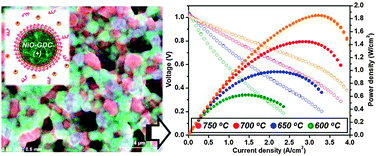Superior power density solid oxidefuel cells by enlarging the three-phase boundary region of a NiO–Ce0.8Gd0.2O1.9 composite anode through optimized surface structure
Abstract
In an effort to boost the power densities of solid

* Corresponding authors
a
Materials Science and Engineering Program, The University of Texas at Austin, Austin, TX 78712, USA
E-mail:
manth@austin.utexas.edu
Fax: +1 512 471 7681
Tel: +1 512 471 1791
b
Materials Science and Engineering Program, Texas A&M University, College Station, TX 77843, USA
E-mail:
wangh@ece.tamu.edu
Fax: +1 979 845 6259
Tel: +1 979 845 5082
In an effort to boost the power densities of solid

 Please wait while we load your content...
Something went wrong. Try again?
Please wait while we load your content...
Something went wrong. Try again?
D. Yoon, Q. Su, H. Wang and A. Manthiram, Phys. Chem. Chem. Phys., 2013, 15, 14966 DOI: 10.1039/C3CP52679H
To request permission to reproduce material from this article, please go to the Copyright Clearance Center request page.
If you are an author contributing to an RSC publication, you do not need to request permission provided correct acknowledgement is given.
If you are the author of this article, you do not need to request permission to reproduce figures and diagrams provided correct acknowledgement is given. If you want to reproduce the whole article in a third-party publication (excluding your thesis/dissertation for which permission is not required) please go to the Copyright Clearance Center request page.
Read more about how to correctly acknowledge RSC content.
 Fetching data from CrossRef.
Fetching data from CrossRef.
This may take some time to load.
Loading related content
